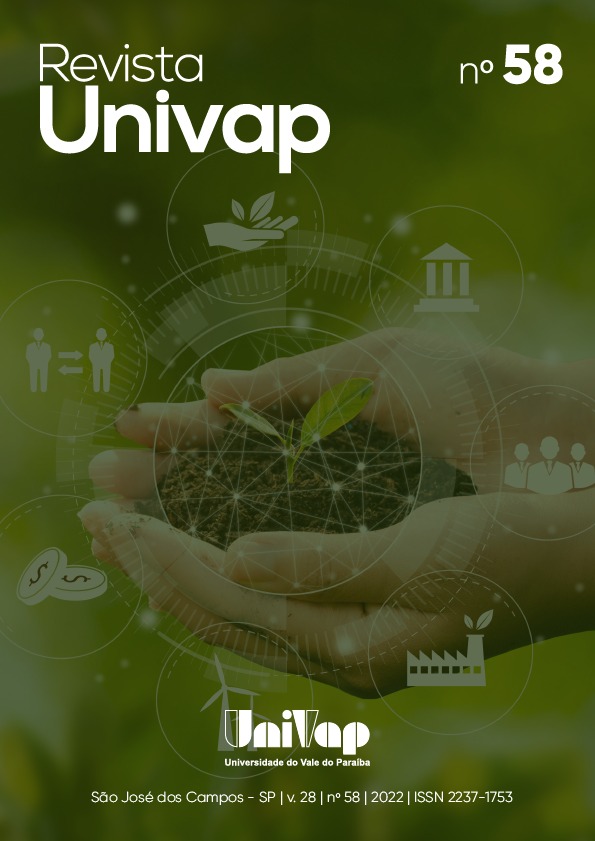CLIMATE COMPARISON AMONG SÃO JOSÉ DOS CAMPOS, PARAIBUNA AND SÃO LUIZ DO PARAITINGA BETWEEN 1940-1970
DOI:
https://doi.org/10.18066/revistaunivap.v28i58.2645Keywords:
Thornthwaite, Hydric balance, Evapotranspiration, GroundAbstract
The use, control and monitoring of water resources each year are becoming more detailed and important for the maintenance and protection of the basins that supply the industry, population and agriculture. The macro- and micro-scale geographic and environmental characteristics are decisive for the microclimate and water availability. To classify the microclimate and water balance, the Thornthwaite method was used for the cities of the Vale do Paraíba Paulista: Paraibuna, São José dos Campos and São Luiz do Paraitinga, with the input of data from 1940 to 1970. The studied municipalities are geographically close, and analyzing land use and occupation, as well as IBGE data, we found their characteristics that differentiate the climate of the municipalities, the anthropogenic interference in areas of the municipality destined to urban and population growth, forest vegetation and the construction of the Paraibuna/Paraitinga dam. The aim of this work is to classify and indicate possible alterations in the microclimate of each municipality, showing that humid microclimates were found, but with different subclassifications, and that the use and occupation of the soil increase some natural characteristics, such as temperature and water storage.
Downloads
References
Agência Nacional de Águas e Saneamento Básico. Hidro Web. Disponível em: https://www.snirh.gov.br/hidroweb. Acesso em: 29 jun 2021.
Blain, G.C. (2009). Considerações estatísticas relativas à oito séries de precipitação pluvial da secretaria de agricultura e abastecimento do Estado de São Paulo. Revista Brasileira de Meteorologia, 24, 12-23.
Camargo, A.P. & Sentelhas, P. C. (1997). Avaliação do desempenho de diferentes métodos de estimativa da evapotranspiração potencial no Estado de São Paulo, Brasil. Revista Brasileira de agrometeorologia, 5 (1) 89-97.
Centeno, J. A. S., Antunes, A. F. B., Trevisan, S. & Correa, F. (2003). Mapeamento de áreas permeáveis usando uma metodologia orientada a regiões e imagens de alta resolução. Revista Brasileira de Cartografia 55(1), 48-56.
Companhia Energética de São Paulo. (2021). Represa Paraibuna/Paraitinga. https://www.cesp.com.br/geracao-de-energia/paraibuna/.
DataGEO. (2021). Sistema ambiental paulista. https://datageo.ambiente.sp.gov.br/app/
DGI INPE. (2022). Limite dos Municípios... Inpe. http://www.dgi.inpe.br/CDSR/.
Empresa Brasileira de Pesquisa Agropecuária. (2003). Banco de dados climáticos do Brasil. https://www.cnpm.embrapa.br/projetos/bdclima/. Embrapa.
Google, Earth Engine. (2021). https://earthengine.google.com/
Instituto Brasileiro de Geografia e Estatística (2020). Censo 2020. https://ibge.gov.br/cidades-e-estados.
NASA. (2021). Landsat 5 | Landsat Science. https://landsat.gsfc.nasa.gov/satellites/landsat-5/
Pivetta, M. (2019). O uso do solo e as mudanças climáticas. Pesquisa FAPESP, (283), 56-59. https://revistapesquisa.fapesp.br/o-uso-do-solo-e-as-mudancas-climaticas/
Projeto MapBiomas (2021). Coleção 6 da Série Anual de Mapas de Uso e Cobertura da Terra do Brasil. https://plataforma.brasil.mapbiomas.org/
Projeto MapBiomas (2022). Mapeamento da Superfície de Água do Brasil Coleção 1. https://plataforma.brasil.mapbiomas.org/agua.
Silva, D. D., Pruski, F. F., Schaefer, C. E. G. R., Amorim, R. S. S. & Paiva, K. W. N. (2005). Efeito da cobertura nas perdas de solo em um Argissolo Vermelho-Amarelo utilizando simulador de chuva. Engenharia Agrícola, 25(2), 409-419.
Thornthwaite, C. W. (1948). An approach towards a rational classification of climate. Geographical Review, 38, 55-94.
Vianello, R. L. & Alves, A. R. (1991). Meteorologia Básica e Aplicações (449 pp). UFV.
Downloads
Published
How to Cite
Issue
Section
License
Copyright (c) 2022 Revista Univap

This work is licensed under a Creative Commons Attribution 4.0 International License.

This work is licensed under a Creative Commons Attribution 4.0 International.
This license allows others to distribute, remix, tweak, and build upon your work, even commercially, as long as they credit you for the original creation.
http://creativecommons.org/licenses/by/4.0/legalcode


